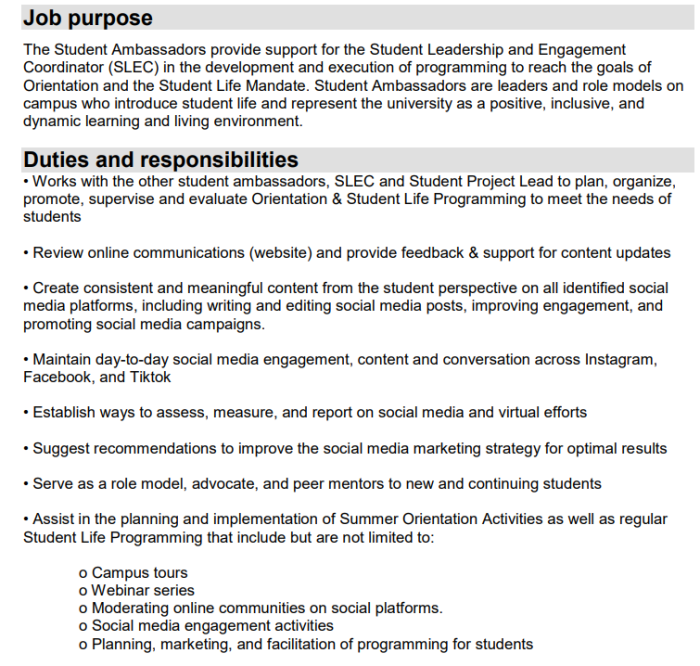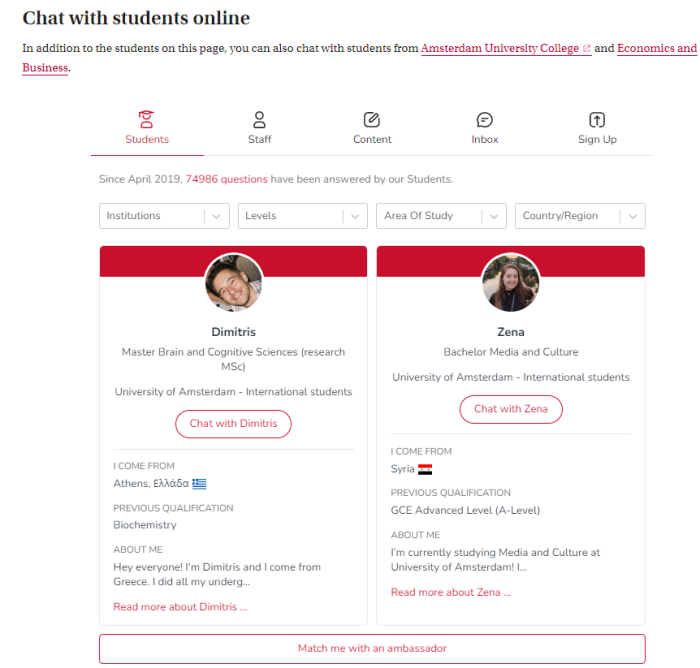Any school looking to increase its engagement on social media may be keen to know about the positive impact a student ambassador program can have. These programs position your current students at the forefront of your marketing efforts, allowing them to connect with your prospects and promote your school and its messaging. By giving your prospects a name and a face they can associate with your school, you’re also providing them with a personality they can interact with—boosting interest in your school.
Not yet sold on the idea of student ambassadors for your school? Here’s an in-depth exploration of the benefits you can expect to see in your overall marketing efforts and the strategies you can apply to launch a successful program!
Empower your students, amplify your brand
Start building your student ambassador program today.

Why You Should Create a Student Ambassador Program for Your School
Students today respond well to personal stories and authentic experiences, even when it comes to education marketing. Research shows that 50% of millennials trust product recommendations from influencers and that 89% of marketers that are using influencer marketing plan to increase or maintain their investment in 2023. Schools looking into influencer marketing can use these statistics to their advantage.
A study by IBM shows that 22% of Gen Z make money online, and an extra 16% work for themselves, implying a strong desire for agency and independence as well as an interest in advocating for brands they believe in. This gives schools a unique opportunity to connect with willing students to showcase the best that they have to offer while also supporting their students.
Have you ever wondered, “What is a school ambassador?” The answer is a current student or member of your community – potentially faculty or parents – who have personal experiences and relationships with your school. They have a unique perspective that can resonate with similar audiences, and using them can help your school easily stand out within your target audience. Some key characteristics of a student ambassador include strong communication skills, a passion for your school, and the ability to connect with and influence their peers. Through an ambassador program, you can invite Gen Z students to become advocates of your school, turning them into student ambassadors.
Your next question may be: “What does a student ambassador do?” A student ambassador is a current student who promotes your brand, working for your school to spread its mission and help with its recruitment efforts. These student ambassadors can contribute to your marketing strategy across various touch points and channels—including posting social media posts, writing blogs, hosting campus tours, and assisting with fairs and fundraising events. The qualities of a student ambassador often include leadership, enthusiasm, and a genuine connection to the school community.
Example: JCU promotes student ambassadors to help prospective students understand more about the university before joining.

Source: John Cabot University
1. Promote Transparency and Build More Meaningful Relationships with Prospects
A school ambassador program can help prospects see your school through the perspective of an actual student, adding a layer of transparency and authenticity to their interaction with your brand. Because it feels more personal, this allows prospects to develop a more meaningful relationship with your school—building their trust and loyalty along the way.
Your student ambassadors’ stories and experiences can also be more potent than your branded content. Student ambassadors know which factors prospects consider when choosing a college, and they can quickly zero in on concerns, speaking to them from a more authentic place. Worries about the classroom environment, accommodations, academics, and other areas of your school can be addressed through personal anecdotes and testimonials, making a positive message much more impactful.
In this way, your student ambassadors can influence the emotional drivers behind enrollment. Their honest opinions and transparency transform into an authentic endorsement that supports a stronger sense of community—one that more naturally fosters relationships and growth within your audience.
Example: The University of Manchester has a Humanities blog that hosts content written by students and members of its community. These blog posts are shared to promote transparency and create a window into student life in this department:

Scrolling further down, prospects can click on articles that share the authentic experiences of current students. These articles are much more likely to resonate with your audience, allowing them to form opinions on your school based on real people and real events:

Source: The University of Manchester
2. Improve Your Content Strategy with User-Generated Content
User-generated content is known to attract prospective customers, and the same can be said about prospects in education. That’s because it adds a layer of authenticity that takes a school’s marketing strategy to the next level in today’s highly digital, oversaturated market. It can also drive engagement and boost your approachability as a band, generating fun and excitement for students participating in this type of content and prospects following it.
Data shows that websites with user-generated content can generate a 20% increase in return visitors and a 90% increase in time spent on their website. On social media, the engagement number of user-generated content posts can be 28% higher than brand posts. Through student ambassador programs, you can rely on user-generated content that resonates and adds to your school’s branded content. Examples include creator content on TikTok and other social media channels or blog posts to social media account takeovers. You can also cross-promote content on one platform with another to expand your reach and impact.
Example: York University uses the Instagram Stories feature to host account takeovers. These stories show student ambassadors with different backgrounds talking about student life on campus and opening the floor for questions—creating additional opportunities for interaction between ambassadors and prospects:

Source: York University
3. Showcase a Vibrant Student Life and Campus with a Student Ambassador Program
Unsurprisingly, prospects are curious about the experience on your campus. Whether you promote campus life or highlight your school’s unique campus services, candidates will want to get an unfiltered perspective.
A common question is what is the goal of the student ambassador Program? Schools can rely on a student ambassador program to present facts and showcase its students’ real, lived experiences. This means giving you a way to share your vibrant student life and campus in a trustworthy way.
You can use this opportunity to promote your school on social media, capture its diversity, and spotlight the various student organizations and activities on offer. Here, an honest and unscripted perspective is key—making prospects feel more connected to your school by giving them the inside scoop. This can directly influence prospects’ decision-making process. Because they’ll be able to witness what goes on at your school themselves or through the eyes of an actual student, they may feel better informed and more confident about their decision to enroll.
Example: The University of Brighton posted a video on YouTube that shows viewers the day-to-day life of a current student. The video introduces us to James, a student who shares some insight into life on the Falmer campus as well as on student accommodations:

Pro Tip: Schools can make ambassador programs for college students appealing by highlighting opportunities for professional growth and leadership. These positions and their benefits may even attract ambitious prospective students—especially those who are already passionate about your school or those looking for early digital media experience.
Wondering what more you can do to elevate your social media strategy? Connect with our team of education marketing experts to discover ways to boost your social media efforts!
Strategies that Can Strengthen Your School’s Student Ambassador Program
For a student ambassador program to be effective, you need to have SMART goals—Specific, Measurable, Attainable, Relevant, and Time-bound goals that highlight what you want your program to achieve. This process goes hand in hand with defining your social media key performance indicators. In doing so, you can give your school the direction it needs to develop a strong ambassador program that aligns with your recruitment goals and marketing efforts.
As you plan your program, remember to factor in managerial responsibilities and internal communication. Two big questions you will need to address are: what is the student ambassador program, and what does it look like for your school? To answer these questions, you’ll need to create a documented job description with clear responsibilities and compensation, a process for selecting and training ambassadors, and a managerial process that oversees these efforts.
1. Have a Clearly Defined Scope of the Student Ambassador Role
You’ll want to have a clearly defined student ambassador definition outlining the skills and expectations that make up this role. To avoid potential confusion, you should also share specific student ambassador responsibilities and benefits—giving candidates an understanding of what they’re signing up for and why they should consider the program in the first place.
Example: The student ambassador job description posted by the University of Northern British Columbia is clearly defined, featuring a specific job purpose along with a list of responsibilities that make it clear what candidates will be tasked with:

Source: University of Northern British Columbia
Aim to develop a program that can improve your student recruitment strategy. This means identifying what you want ambassadors to do and aligning their actions with your school’s overall marketing and recruitment objectives. Activities and responsibilities can cover these four distinct areas:
- In-person or online recruitment events: participating in info sessions and campus tours, promoting fairs and fundraisers, joining student orientations, etc.
- Online messaging or instant chats: connecting with prospects directly via email, text, or chat and guiding them throughout the enrollment process
- User-generated content: creating social media posts, producing videos, writing articles, etc.
- Lead nurturing or mentorship: hosting student shadow days, supporting school campaigns, participating in mentor programs, etc.
Here, student ambassadors take your school’s message and add their own personal perspective to it before sharing it with your audience. In this way, they act as your school’s media facilitator online and as part of your community outreach or recruitment team offline. To get their unfiltered voice and promote a connection with your prospects, avoid micromanaging your student ambassadors and scripting their reactions. Everything needs to feel genuine, and that includes their contribution to your digital marketing efforts.
2. Knowing What to Look for in Your Future Student Ambassadors
You want to make sure that you choose the right students for the role. These candidates will embody the attributes of your ideal student and will also be enthusiastic about representing your school. Great student ambassador qualities to look for include:
- Being well-connected and involved in student organizations and activities
- Having experience or interest in marketing and communications
- Being a talented content creator, able to produce content that suits your school’s brand and voice
- Having an existing online presence, ideally with high engagement or follower count
- Being genuinely interested in your school and its brand, mission, or values
Example: To facilitate the student ambassador selection process, University College London created a list of qualities that they’re looking for. This list spans both skills and experience, highlighting their importance along with how they will be assessed:

Source: University College London
When choosing your ambassadors, consider training them in your school’s brand guidelines. That’s only to make sure that your admissions team and your ambassadors are all on the same page. Besides, this enables your student ambassadors to know what your school prioritizes and how it positions itself as a brand. With this knowledge, they’ll be able to capture your core values in their own messaging, making it feel authentic to both your brand and your audience.
3. Consider Student-to-Student Marketing Tools in Your Student Ambassador Program
Student-to-student marketing platforms can be extremely helpful for schools looking to promote connections between their ambassadors and prospects. These platforms make it possible for prospects to chat with current students, and the outcome of these conversations can directly impact prospects’ decision to apply.
According to statistics, 51% of students in Asia said that an online chat with a student ambassador influenced their decision to apply to a university. This number increased to 69% in Africa and 62% in Europe. Interestingly, Prospects at the graduate level found these interactions extremely influential, with 56% saying it affected their decision to apply to university.
Student-to-student marketing tools re-envision higher education student recruitment, giving ambassadors more responsibility and positioning them as a key touchpoint in the prospect’s student journey. Platforms like Unibuddy are a great example, giving ambassadors access to a central dashboard where they can view assignments and connect with prospects. The platform allows prospects to view a digital directory of different ambassadors based on certain criteria – such as area of study or nationality – for added personalization.
Example: The University of Amsterdam uses Unibuddy to give prospects a chance to reach out to students. Here, prospects can filter a list of student ambassadors based on the factors they care most about and read a brief introduction before chatting with them:

Source: University of Amsterdam
Your school doesn’t need to rely on these platforms to use this strategy. Simply pointing prospects to an email, social media account, or phone number can be just as effective. Concordia University’s John Molson School of Business takes this approach when introducing its student ambassadors:

Prospects can reach out to the email linked above, or they can get in touch with specific student ambassadors. Once prospects click on an ambassador’s profile, they’re redirected to a page that summarizes their background, interests, and insights while also linking their LinkedIn profile page for further correspondence:

Source: Concordia University’s John Molson School of Business
4. Incentivize Your Student Ambassadors to Make the Role More Appealing
You want to make the ambassador role appeal to your current students, so it’s a chance for you to cultivate a mutually beneficial relationship. This means carefully considering the benefits of being a student ambassador. The role itself should be fun and enjoyable for students, but it should also be a way for them to gain professional growth.
Perhaps your school can provide financial compensation. You can also offer work experience with your school’s recruitment or marketing team, allowing them to expand their resume. Maybe your school could offer a mentorship program where experienced ambassadors train those just starting out, fulfilling leadership responsibilities. By offering your students training in social media or content creation, you can help them learn in-demand and transferable skills they can use in the future. You can also ask your students: “Why do you want to be a student ambassador?” The insights you receive can help you shape your student ambassador program.
Example: To incentivize its student, the University of Leeds introduces its student ambassador position by promising opportunities for them to develop their skills and enhance their CV. The post also clearly states that it’s a paid position, making it more appealing:

Putting in the effort to present an appealing student ambassador position can make a difference in your marketing and recruitment efforts. If you’re successful, then you’ll be able to attract eager and loyal students who can give your school brand a more personal and human voice—encouraging prospects to place their trust in your overall message.
Empower your students, amplify your brand
Start building your student ambassador program today.







